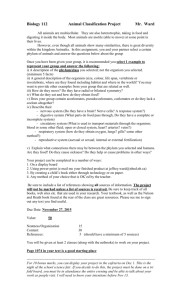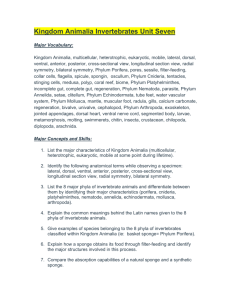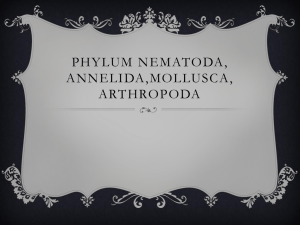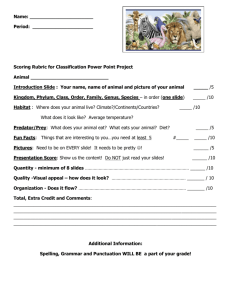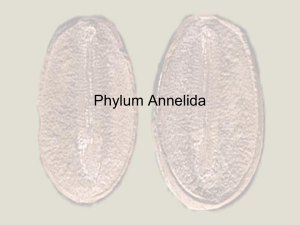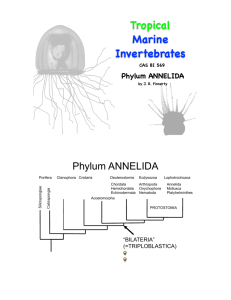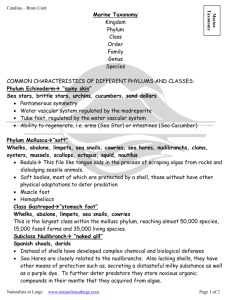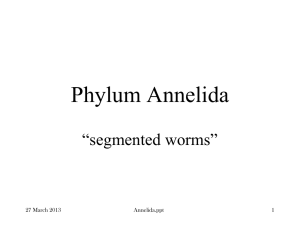Phylum Annelida
advertisement
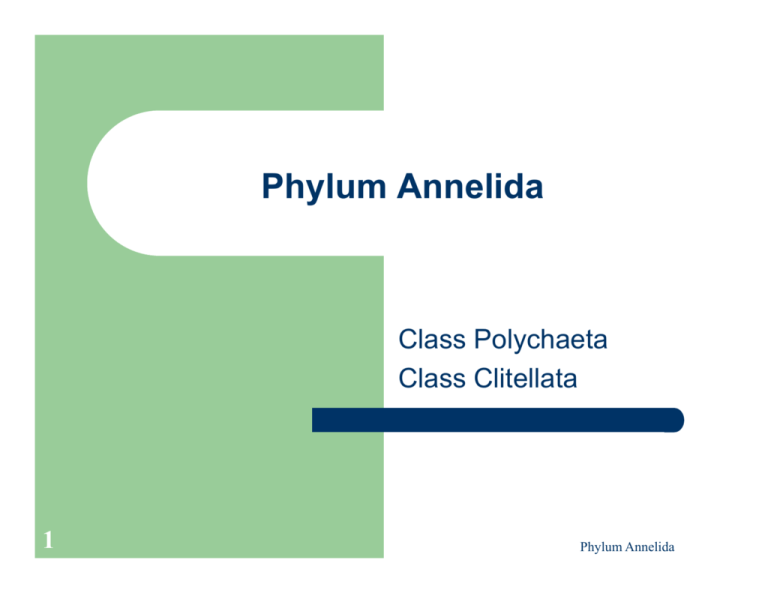
Phylum Annelida Class Polychaeta Class Clitellata 1 Phylum Annelida Annelid Characteristics z Defining Characteristics – z The phylum includes polychaetes, earthworms, leeches, and vestimentiferans z True segmented worms – 2 One or more pairs of chitinous setae Metameric segmentation Phylum Annelida Body Structure z 3 The body is a tube within a tube z The coelom is important to annelids for: z The epidermis is what secretes the tough cuticle Phylum Annelida Locomotion z z 4 On each side of the animal is a parapod (parapodia) consisting of fleshly lobes, which are supported by chitinous rods Each parapod have setae, which can be sharp (protection), and aid in locomotion Phylum Annelida Digestive System 6 Phylum Annelida Circulatory System z z z 7 Blood flows entirely in closed vessels Some spp. have hearts Blood contains hemoglobin, which increases oxygen carrying ability Phylum Annelida Excretory & Nervous System Nervous system 8 Phylum Annelida Reproduction z Sexes are usually separate with gonads occurring in each segment – z z z z 9 Some species have gonad specific segments Breeding is usually seasonal (spring or fall) As gametes mature they fill the coelom and are released by the nephridia Fertilization can be internal or external Trochophore larvae develop, which are remarkably similar to the Molluscs Phylum Annelida Taxonomic Summary z Phylum Annelida – Class Polychaeta z – Class Clitellata z z 10 Family Siboglinidae Subclass Oligochaeta Subclass Hirudinea Phylum Annelida Class Polychaeta 11 z Defining characteristics – Parapodia? z Some tube species lack parapodia but it is believed to have been lost z Parapodia differ from species to species and play an important role in identification Phylum Annelida Polychaete Lifestyles z Crawling polychaetes Pelagic polychaetes Burrowing polychaetes z Tube-dwelling polychaetes z z 12 Phylum Annelida Reproduction z z z 13 Dioecious with gametes released into the coelom Many species reproduce en masse at the surface at night Moonlight and artificial light attract spawning masses Trochophore Phylum Annelida Epitokes z z 14 Epitoky – Theses are given the task of reproduction – Some individuals bud epitokes from the body and remain in the habitat Some species lack a freeswimming or plankton stage, and are produced in protective gelatinous egg masses Phylum Annelida Family Siboglinidae z Defining characteristic – – z 15 Gut tissue forms an organ (trophosome) that becomes filled with chemosynthetic bacteria Segmentation confined to small rear portion of animal (the opisthosoma) Small intriguing class of tube dwelling worms All 120 species are marine and can found throughout the be found in high concentrations on worlds oceans hydrothermal vents Phylum Annelida Trophosome z z z 16 The major organs (gonads and trophosome) are found in the coelom The trophosome of all species contains closely packed bacteria and play a crucial role in nutrition The last segment is the opisthosoma, which has many segments and septa like polychaetes Phylum Annelida Chemosynthetic Bacteria z The most interesting aspect of pogonophora is the lack of a digestive system – – 17 Bacteria in the trophosome fix the chemicals leaving the vents The bacteria can occur at concentrations of 10 billion per gram of trophosome tissue Phylum Annelida Class Clitellata z z Subclass Oligochaeta Defining characteristics – z z 18 Pronounced cylindrical glandular region of the body = clitellum Second largest class in the phylum Annelida Most spp. are earthworms, very few are marine Phylum Annelida Polychaetes and Oligochaetes z Oligochaetes differ from polychaetes in several ways: – – – 19 No parapods, fewer setae (if at all) Hermaphroditic with sex cells produced in a separate section No larval stages Phylum Annelida Class Clitellata z z z z 20 Subclass Hirudinea Defining characteristics – Posterior sucker Predominately freshwater, but do occur in all seas and moist soil Leeches do not burrow or crawl, lack parapods and setae Phylum Annelida Leech Anatomy z z 21 Anterior sucker is small and contains the mouth – Anterior sucker creates a wound with saw like jaws Leeches drink other animals’ blood, usually vertebrates – Can be carnivores, or scavengers; leeches are not set in their feeding habits Phylum Annelida Leech Reproduction z z z 23 Leeches are simultaneous hermaphrodites that lack a free-living larvae stage Fertilization is internal through copulation Development occurs in a cocoon similar to the Oligochaetes Phylum Annelida
